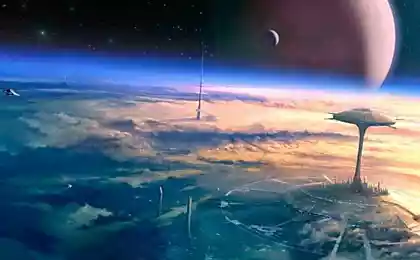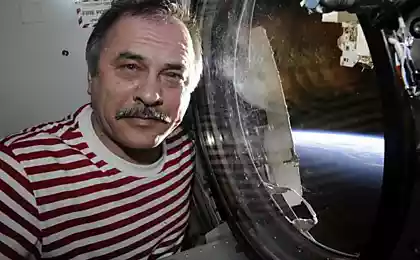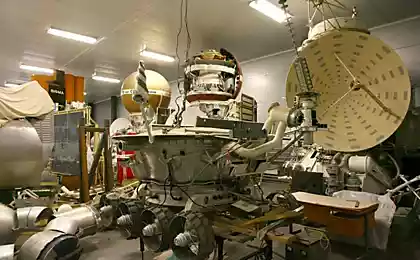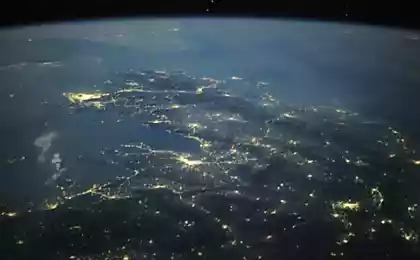1382
Photos space
Hyperion: Saturn's strange craters

What is at the bottom of strange craters Hyperion? Nobody knows. To help find out, the robotic Cassini spacecraft now orbiting Saturn referring, in late 2005 and in 2010 went about Hyperion and received images of its surface with an exceptionally high resolution. In the image shown here in standard colors, you can see the wonderful world of the satellite, like a sponge, unusual surface is covered with strange craters. Slight color differences apparently represent variations in the chemical composition of the surface. At the bottom most craters is unknown some dark material. The presence of light components in this image shows that in some areas the thickness of the dark material may be only a few dozen meters. Hyperion size - about 250 kilometers. Galaxy porpoise

What's wrong with this spiral galaxy? Only a few hundred million years ago, NGC 2936 (top of two large galaxies in the picture) was probably normal spiral galaxy: it rotates created the stars, in general, do their own thing. But once she got too close to a massive elliptical galaxy NGC 2937 and lost its way. NGC 2936, a galaxy known as the porpoise for its unusual shape, not just a twisted, she always strongly deformed due to strong gravitational interaction with a neighbor. Newly formed blue stars formed nose porpoise space, looking to the left and the middle helix looks like her eyes. A pair of galaxies together bearing the name of Arp 142, looks like a penguin protecting its eggs. In any case, the intricate dark dust filaments and their tails blue stars tie the top with the bottom galaxy. This recently published photographs of the galaxy Arp 142 in unprecedented detail, was taken by the Hubble Space Telescope last year
NGC 6302: Butterfly Nebula

Not many butterflies have such a large wingspan. Bright clusters and nebulae in the night sky of the planet Earth are often given names by the names of flowers or insects, and the nebula NGC 6302 is no exception. The central star of a planetary nebula extremely hot temperature of its surface is about 250 thousand degrees Celsius. It shines brightly in the ultraviolet range, but hidden from direct observation dense torus of dust. It's surprisingly detailed image of the nebula around a dying star was obtained Hubble Space Telescope soon after its renovation in 2009. Dust ring surrounding the central star, crosses a bright cavity of ionized gas, and we can see almost exactly edge-on. Molecular hydrogen has been detected in cosmic dust shroud hot star. Nebula NGC 6302 is located about 4 thousand light-years away in the constellation Scorpius.
Halo super moon

When the sun sets on the last Sunday, full moon at perigee. She was the closest to the Earth, and therefore the brightest and biggest full moon this year, and it was called the super-moon. Light super-moon has created a magnificent circular halo, which can be seen from Punta Piedras and the mouth of the Rio de la Plata near Buenos Aires in Argentina. The size of the lunar halo determined by the geometry of hexagonal ice crystals in high, thin clouds on Earth. The crystals are strongly reflected rays of moonlight at an angle of 22 degrees. Therefore, the inner radius of the halo - 22 degrees, it does not depend on the apparent size of the moon. Beautiful halo with a radius of 22 degrees can be seen at any time of the year, much more than a super-moon.
Strip of dry ice on Mars

Why on Mars were so long and almost straight grooves? They are formed on the slopes of some sand dunes during the Martian spring, they are called "linear gullies." The grooves have almost constant width, their length is two kilometers along their edges are trees rising above the surrounding sand. Unlike most of the water streams, they do not form regions with dry rock eroded at the end of the slopes. A leading hypothesis that has been tested on Earth, linear gullies are formed when pieces of ice from carbon dioxide (dry ice) break off and slide down the slope, sublimating into gas, and in the end completely evaporate into thin air. If this is true, in the future, adventurers will be able to drive on these natural "sledging" dry ice, moving hovercraft from evaporating carbon dioxide
Full Moon at perigee

Large, bright, beautiful moon rise on Sunday, when the Sun will sit. The exact time of the full moon - June 23, 11:32 UT. It will take place shortly before the Moon will pass perigee - the closest point to the Earth in orbit of the Moon. Thus, it will be the biggest full moon of 2013. However, such circumstances are not very rare. The full moon occurs near the perigee of the lunar orbit about 14 lunar months. This means that the next full moon at perigee occurs August 10, 2014, it will be the 14th full moon after 23 June. On May 5, 2012, the 14 lunar months ago, the full moon is at perigee was captured rising over the Cape Sounion and the ancient temple of Poseidon in Greece on this beautiful night scenery.
Star-forming region NGC 3582

There's brightest stars are formed and causes the molecule of interest. Nebula with light structure is in the star-forming region called RCW 57. This image shows dense clumps of dark interstellar dust, bright stars that have formed over the past few million years, fields of glowing hydrogen gas ionized by these stars, and great loops of gas discharged dying stars. The last detailed study of NGC 3582 has revealed at least 33 massive stars that are in the final stages of formation, and the apparent presence of complex carbon-containing molecules known as polycyclic aromatic hydrocarbons. It is assumed that these molecules occur in the cooling gas in star-forming regions, and their appearance in the nebula from which five billion years ago, the sun formed, could be an important step in the development of life on Earth.
Side view of the galaxy NGC 3628

Clear telescopic images gorgeous spiral galaxy NGC 3628, which we see the side show a galactic disk, crossed by dark dust lanes. This remarkable kind of reminds astronomers its popular name - Galaxy Hamburger. The diameter of NGC 3628 - about 100 thousand light years and lies in the northern spring constellation Leo, at a distance of 35 million light-years.
Sharpless 115
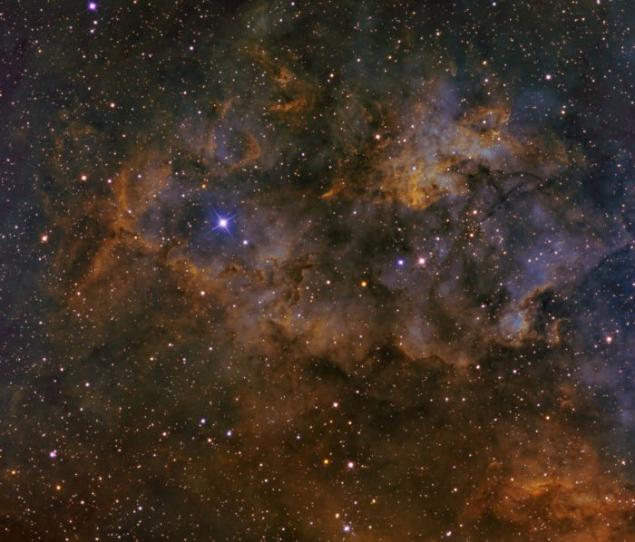
Object Sharpless 115 is a little northwest of Deneb - the brightest star in the constellation Cygnus on planet Earth's sky. This cute, but slightly luminous nebula recorded in the catalog 1959 astronomer Stewart Sharpless at number Sh2-115, lies about 7500 light-years away at the edge of a giant molecular cloud on the outskirts of the Milky Way. Light Nebula, visible on this composite image in artificial palette Hubble Space Telescope, create ionized atoms of hydrogen, sulfur and oxygen. They are fueled by high-energy radiation of young stars in the cluster, Berkeley 90. This accumulation of probably about 100 million years, and it is still hiding inside the nebula Sharpless 115
Once the molten surface of Venus
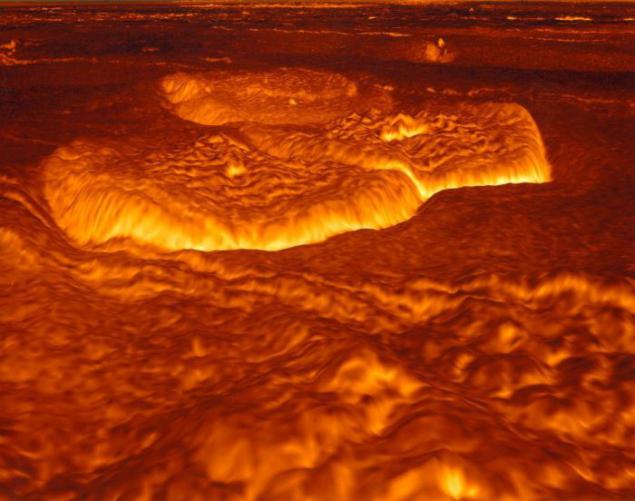
If you look at Venus radar eyes, we have the following picture will appear. Figure the surface of Venus obtained by computer reconstruction based on observations of the interplanetary station Magellan. Magellan station in orbit around Venus in 1990-1994. To map the surface of our neighboring planet used radar. With Magellan was discovered many interesting formations on the surface of the planet, in particular, those big round dome with a typical size of 25 km. The mechanism of their formation remains unclear. Perhaps the dome arose as a result of volcanic activity. The surface of Venus is so hot and hostile that the probe can work on it only a few minutes.
All Mercury
First the map of the entire surface of the planet Mercury. Detailed observations of the amazing crust closest planet to the Sun are carried out with as long as the robot spacecraft MESSENGER first flew past Mercury in 2008 and went on its orbit in 2011. Previously, the majority of Mercury's surface remained unexplored. Planet too far to ground-based telescopes were able to get it clear image, while fly-by Mariner 10 in the 1970s managed to otnablyudat only about half of the surface. The video was edited from thousands of images of Mercury, the colors which have been strengthened in order to better distinguish the structures on the surface. The film shows the rotation of the planet, and we see the first rays formed after the collision occurred in the north and stretch for most of the planet. Around the middle of the movie appears painted in bright colors Caloris basin - an ancient structure in the north, which arose after the collision and then filled with lava. Messenger has successfully completed basic and advanced first program.

What is at the bottom of strange craters Hyperion? Nobody knows. To help find out, the robotic Cassini spacecraft now orbiting Saturn referring, in late 2005 and in 2010 went about Hyperion and received images of its surface with an exceptionally high resolution. In the image shown here in standard colors, you can see the wonderful world of the satellite, like a sponge, unusual surface is covered with strange craters. Slight color differences apparently represent variations in the chemical composition of the surface. At the bottom most craters is unknown some dark material. The presence of light components in this image shows that in some areas the thickness of the dark material may be only a few dozen meters. Hyperion size - about 250 kilometers. Galaxy porpoise

What's wrong with this spiral galaxy? Only a few hundred million years ago, NGC 2936 (top of two large galaxies in the picture) was probably normal spiral galaxy: it rotates created the stars, in general, do their own thing. But once she got too close to a massive elliptical galaxy NGC 2937 and lost its way. NGC 2936, a galaxy known as the porpoise for its unusual shape, not just a twisted, she always strongly deformed due to strong gravitational interaction with a neighbor. Newly formed blue stars formed nose porpoise space, looking to the left and the middle helix looks like her eyes. A pair of galaxies together bearing the name of Arp 142, looks like a penguin protecting its eggs. In any case, the intricate dark dust filaments and their tails blue stars tie the top with the bottom galaxy. This recently published photographs of the galaxy Arp 142 in unprecedented detail, was taken by the Hubble Space Telescope last year
NGC 6302: Butterfly Nebula

Not many butterflies have such a large wingspan. Bright clusters and nebulae in the night sky of the planet Earth are often given names by the names of flowers or insects, and the nebula NGC 6302 is no exception. The central star of a planetary nebula extremely hot temperature of its surface is about 250 thousand degrees Celsius. It shines brightly in the ultraviolet range, but hidden from direct observation dense torus of dust. It's surprisingly detailed image of the nebula around a dying star was obtained Hubble Space Telescope soon after its renovation in 2009. Dust ring surrounding the central star, crosses a bright cavity of ionized gas, and we can see almost exactly edge-on. Molecular hydrogen has been detected in cosmic dust shroud hot star. Nebula NGC 6302 is located about 4 thousand light-years away in the constellation Scorpius.
Halo super moon

When the sun sets on the last Sunday, full moon at perigee. She was the closest to the Earth, and therefore the brightest and biggest full moon this year, and it was called the super-moon. Light super-moon has created a magnificent circular halo, which can be seen from Punta Piedras and the mouth of the Rio de la Plata near Buenos Aires in Argentina. The size of the lunar halo determined by the geometry of hexagonal ice crystals in high, thin clouds on Earth. The crystals are strongly reflected rays of moonlight at an angle of 22 degrees. Therefore, the inner radius of the halo - 22 degrees, it does not depend on the apparent size of the moon. Beautiful halo with a radius of 22 degrees can be seen at any time of the year, much more than a super-moon.
Strip of dry ice on Mars

Why on Mars were so long and almost straight grooves? They are formed on the slopes of some sand dunes during the Martian spring, they are called "linear gullies." The grooves have almost constant width, their length is two kilometers along their edges are trees rising above the surrounding sand. Unlike most of the water streams, they do not form regions with dry rock eroded at the end of the slopes. A leading hypothesis that has been tested on Earth, linear gullies are formed when pieces of ice from carbon dioxide (dry ice) break off and slide down the slope, sublimating into gas, and in the end completely evaporate into thin air. If this is true, in the future, adventurers will be able to drive on these natural "sledging" dry ice, moving hovercraft from evaporating carbon dioxide
Full Moon at perigee

Large, bright, beautiful moon rise on Sunday, when the Sun will sit. The exact time of the full moon - June 23, 11:32 UT. It will take place shortly before the Moon will pass perigee - the closest point to the Earth in orbit of the Moon. Thus, it will be the biggest full moon of 2013. However, such circumstances are not very rare. The full moon occurs near the perigee of the lunar orbit about 14 lunar months. This means that the next full moon at perigee occurs August 10, 2014, it will be the 14th full moon after 23 June. On May 5, 2012, the 14 lunar months ago, the full moon is at perigee was captured rising over the Cape Sounion and the ancient temple of Poseidon in Greece on this beautiful night scenery.
Star-forming region NGC 3582

There's brightest stars are formed and causes the molecule of interest. Nebula with light structure is in the star-forming region called RCW 57. This image shows dense clumps of dark interstellar dust, bright stars that have formed over the past few million years, fields of glowing hydrogen gas ionized by these stars, and great loops of gas discharged dying stars. The last detailed study of NGC 3582 has revealed at least 33 massive stars that are in the final stages of formation, and the apparent presence of complex carbon-containing molecules known as polycyclic aromatic hydrocarbons. It is assumed that these molecules occur in the cooling gas in star-forming regions, and their appearance in the nebula from which five billion years ago, the sun formed, could be an important step in the development of life on Earth.
Side view of the galaxy NGC 3628

Clear telescopic images gorgeous spiral galaxy NGC 3628, which we see the side show a galactic disk, crossed by dark dust lanes. This remarkable kind of reminds astronomers its popular name - Galaxy Hamburger. The diameter of NGC 3628 - about 100 thousand light years and lies in the northern spring constellation Leo, at a distance of 35 million light-years.
Sharpless 115

Object Sharpless 115 is a little northwest of Deneb - the brightest star in the constellation Cygnus on planet Earth's sky. This cute, but slightly luminous nebula recorded in the catalog 1959 astronomer Stewart Sharpless at number Sh2-115, lies about 7500 light-years away at the edge of a giant molecular cloud on the outskirts of the Milky Way. Light Nebula, visible on this composite image in artificial palette Hubble Space Telescope, create ionized atoms of hydrogen, sulfur and oxygen. They are fueled by high-energy radiation of young stars in the cluster, Berkeley 90. This accumulation of probably about 100 million years, and it is still hiding inside the nebula Sharpless 115
Once the molten surface of Venus

If you look at Venus radar eyes, we have the following picture will appear. Figure the surface of Venus obtained by computer reconstruction based on observations of the interplanetary station Magellan. Magellan station in orbit around Venus in 1990-1994. To map the surface of our neighboring planet used radar. With Magellan was discovered many interesting formations on the surface of the planet, in particular, those big round dome with a typical size of 25 km. The mechanism of their formation remains unclear. Perhaps the dome arose as a result of volcanic activity. The surface of Venus is so hot and hostile that the probe can work on it only a few minutes.
All Mercury
First the map of the entire surface of the planet Mercury. Detailed observations of the amazing crust closest planet to the Sun are carried out with as long as the robot spacecraft MESSENGER first flew past Mercury in 2008 and went on its orbit in 2011. Previously, the majority of Mercury's surface remained unexplored. Planet too far to ground-based telescopes were able to get it clear image, while fly-by Mariner 10 in the 1970s managed to otnablyudat only about half of the surface. The video was edited from thousands of images of Mercury, the colors which have been strengthened in order to better distinguish the structures on the surface. The film shows the rotation of the planet, and we see the first rays formed after the collision occurred in the north and stretch for most of the planet. Around the middle of the movie appears painted in bright colors Caloris basin - an ancient structure in the north, which arose after the collision and then filled with lava. Messenger has successfully completed basic and advanced first program.






